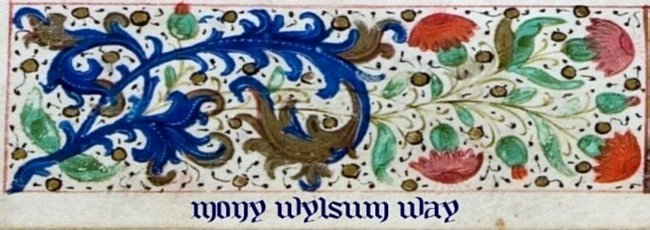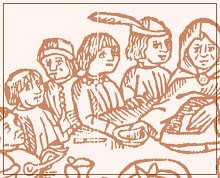So, a couple of weeks back I discussed the disjointed nature of some of the vitae in the Gilte Legende (ed. Richard Hamer, EETS OS 327-8, 2006-7). I also mentioned the plethora of stories of Julians that the author tells under the entry for St Julian (v. 1 pp. 141-47) just to make sure we know which St Julian is the right St Julian; but despite the generally confused nature of that entry, the story of St Julian itself is beautifully symmetrical, and his saintly functions relate perfectly to the events of his life.
Briefly, the story is this. Fleeing a prophecy that he will kill both his parents (laid on him as punishment by a hart he was hunting), he moves away, marries and conveniently gets set up as a lord in a nicely feudal castle, as happens to so many unconnected vagabonds. When his parents find his castle, his wife invites them in, realises who they are, lavishes hospitality on them and gives up her bed to them, going to sleep elsewhere for the night. Returning home, he sees a man and a woman in his wife’s bed and kills them both in a fit of jealousy. As he emerges from the bloody chamber he meets his wife emerging, pointedly, from the chapel, and is slightly chagrined to hear her explanation. Realising that “whan I wende to eschewe this sorifull dede I most cursed haue fulfelled it” (144), he flees his castle and society and goes hermit – with his wife, who refuses to desert him. “And thanne they went togedre besides a grete flode where many men perisched, and there besides in that desert thei made a litell hospitall for to do there penaunce and for to bere ouer all tho that wolde passe” (ibid), until one day a horrible slimy smelly old leper turns up and says HELP ME ACROSS THE RIVER. Well, given the Greek-myth heritage of this story which has already been so obvious I didn’t even bother to use the word Oedipus anywhere, we know how this bit goes. He helps the leper, takes him in and feeds him and, because he's dying of cold, “toke hym in his armes and bare hym to his bedde and hilled hym diligently” (ibidetc). And lo and behold, the leper is secretly an angel sent by God to receive his penance and promise him that he will be taken to God soon. Incidentally, that “hilled” is probably “healed” but could also mean “cover, wrap” and possibly “embrace”. So perhaps it’s not surprising that if he was cuddling a leper (who probably had flu, and also fleas) in his bed, it was only “a litell after” that he and his wife both “slepten in oure Lorde Ihesu Crist”.
Just like Sir Gawain, this story invites diagrams. So:

No, I'm not procrastinating, why do you ask?
The story is driven by three revelations, each following an action of Julian’s. Pursuit of the hind leads to a prophecy, the murder of his guests is followed by the revelation of their identity and charity to the leper is followed by the revelation of the angel. In turn, each revelation leads to a journey:

I COULD continue to elaborate this picture and add all the other little structural things mentioned below and more, but I don't think Paint would let it be legible after another two lines or so.
Interestingly, the first two journeys are principally away, fleeing a prophecy and his shame respectively. It is only the third journey, instigated by God, that is a journey to a specific destination. Also, the first journey would seem to be in an upwards direction: socially, he ascends, and topographically he ends up in a nice tall castle which is presumably on some sort of a hill. But the folly of this social and earthly ascension is revealed by the consequences of his (newly acquired?) social pride, when his jealousy leads him to murder. The next journey is deliberately downwards, through the social scale and to the banks of “a grete flode”, and it is here that the spiritual state is reached which allows him to ascend correctly in the end. Or, to put it another way, his initial quest is away from his birth identity, now revealed as dangerous, to one which is more socially pleasing and validated by the community but leads to grave sin through a lack of his own self-knowledge (failing to recognise his parents), and thence towards social obscurity that leads him to discover a purer and truer identity in God.There are other pleasing little contrast-dualities happening in the structure:
- Most obviously, Julian’s attitude to his guests changes from the initial monstrous misunderstanding of his duties as host (and son) to his parents, to the self-sacrificing devotion he shows to an unfamiliar leper (who stands in for his spiritual father). There are shades of a similar guest in the hart, not recognised by Julian even as human until it speaks, and thereby foreshadowing his slaughter of his parents.
- Wilderness vs. culture, where the first (initial forest, final flood) bracket the second and seem to be places of truth and self-knowing, while the second causes obscurity of the soul and blinds with frivolous things.
- More specifically, the bedroom vs. the church. Note that, while Julian was in his bedroom being murderous, lustful, prideful, greedy et al, his wife was in the church, dutifully at her morning prayer after being beautifully hospitable and giving up her bed to the guests. Both emerge from their respective spaces of darkness and light at the same moment, and it is the sight of her that initiates the revelation of Julian’s error (“and whanne he seigh her he hadde mervaile”, 144), removing his blindness.
- His wife has a pleasing sense of symmetry also, promising to stay with him in good time and in bad, “for sethe I haue parted with you in ioye I shall be partener of your sorw”. Their impending departure (and de-part in Middle English could also mean divide) “parts” the story into two, and there is a sense that her presence and her “part” in his fate will be a decisive factor in making this a clean break, providing a sort of rebirth.
- The initial promise of the hart is echoed and laid to rest in the promise of the angel, the first predicting dire acts and bloody division from his parents, the second imminent peace and reunion with his heavenly father.


.jpg)


1 comment:
I am now feeling as if I need to post my diagram of ideology in the Investiture Controversy, and reminding myself that it's not a competition Jarrett etc. What I think this mainly shows is that you must be or will be an excellent teacher, though it may hurt to leave out some of the details...
Post a Comment